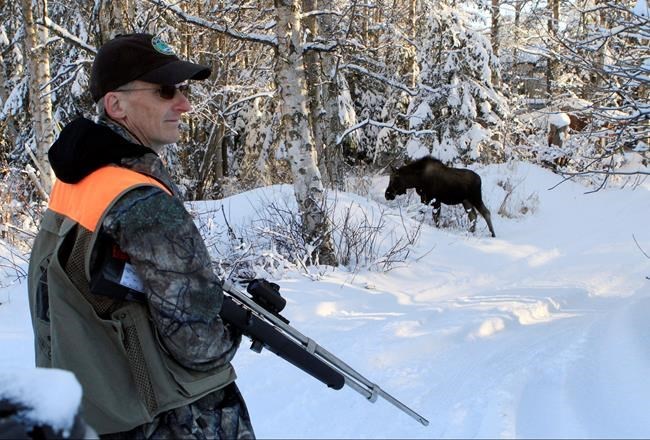
FILE - In this Feb. 23, 2018, file photo, Dave Battle of the Alaska Department Fish and Game waits for a moose to move off after he fired a dart into its side that's collects a skin sample in Anchorage, Alaska. Flight rules over the city prevent the department from conducting traditional aerial surveys of moose so the department conducts a ground survey. Using reports called in by citizens, biologists drive to neighborhoods and collect DNA samples with the dart projectors that look like hunting rifles. (AP Photo/Dan Joling, File)
February 19, 2020 - 3:31 PM
ANCHORAGE, Alaska - The Alaska Department of Fish and Game will conduct its fourth survey of moose in the Anchorage area with the help of citizen scientists.
The three-day survey relies on citizens to call or text in sightings of moose. The 2020 survey begins at 8 a.m. Friday and runs through 5 p.m. Sunday.
Biologists in less populated areas conduct moose surveys from the air. Pilots fly paths close to the ground and circle when they spot moose. Anchorage air traffic and flight restrictions make that impossible, said Dave Battle, area biologist.
“It's just not something that can be done in the Anchorage Bowl," he said.
Anchorage spans 1,963 square miles (5,080 square kilometres), an area the size of the U.S. state of Delaware, with a population as of July 2018 of 291,500. Residents embrace moose as part of the landscape, and the animals at times can be seen in the busiest parts of the city.
Absent an air survey, the department starting in 2017 tried a ground survey. Biologists and technicians take citizen reports, drive out to neighbourhoods and forest land to locate moose and take DNA samples with specialized darts. The darts lightly prick the moose, collect a skin sample and fall to the ground minutes later.
Researchers use the DNA to identify how the moose are related. They can calculate the ratio of bulls to cows. The samples also contribute to a database to identify individual moose, without the expense of capturing them.
“The public’s help the past several years has made all the difference,” said David Saalfeld, a wildlife research biologist, in the survey announcement. “With Anchorage residents calling in, we were able to collect samples and establish a minimum count of 143 unique moose in 2018, and 174 unique moose in 2019, with a recapture rate of 33%."
The analysis that followed produced a rough population estimate of about 350 moose within Anchorage, Saalfeld said. The estimate will be refined as the study is repeated, he said.
Sightings may be reported by calling 907-267-2530; sending a text message at 907-782-5051; or by communicating online at www.adfg.alaska.gov
Biologists want to know the number of moose seen, the time of the sighting and the location of the moose.
The department warned citizens not to approach moose or survey teams darting them. Department teams will wear blaze orange vests or jackets in safety-yellow, and drive department trucks, to identify themselves. They will carry dart projectors that look like hunting rifles.
News from © The Associated Press, 2020